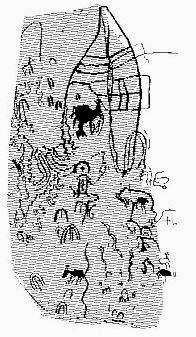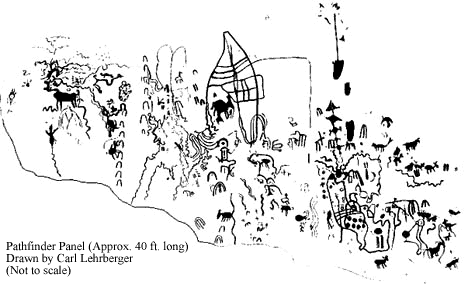 |
| Equinox Shadow representation |
Wednesday, April 15, 2015
Old World Graffiti ~ part 2
The man who did so much for these enigmatic sites was
William McGlone who lived in the La Junta area. He was a retired engineer
who served in the Navy. McGlone was a very scientific man who always wanted his
discoveries and theories verified by outside sources. He enlisted the aid
of many fellow engineers and scientists in deciphering the Ogham. To
McGlone, some of these rock carvings appeared to be much more than mere doodles
in stone, or the graffiti of Native Americans. He saw writing, with letters and
repeated symbols. Over the years, McGlone had attempted to identify these
letters and, shortly before his death in 1999, he had made a reasonable
argument that some of the petroglyphs were from an Arabic alphabet which would
have been used by Turkish sailors around 500 BC.
Crack Cave is located just north of the Colorado/Oklahoma state
line. The area where it is found is called Picture Canyon. The abundance of
petroglyphs here gave rise to the name Picture Canyon. Inside one of the
many crevasses that might be called a cave is an
archaeo-astronomical site that is only observable on the Spring & Autumn
Equinoxes. 3 sets of Ogham inscriptions are found inside - the first which is
located at the back of the cave, translates to the Celtic Sun God. On the South
wall the inscription reads, People of the Sun.
On the north wall is the third inscription - The Sun Strikes Here
on the Day of Bel (Bel is short for Belenus, the Celtic Sun God's name). This
last glyph is the one illuminated at sunrise on the Equinoxes. Above this last
glyph are count marks which tell how many days to the Equinox. The morning of
the Equinox, all the marks are illuminated. Today, the cave opening is
protected with a metal grate to prevent vandalism but the gate is opened on the
equinoxes by the park rangers to allow the public to view the alignment.
Sun Temple is located to the NW of Crack Cave (about halfway to La
Junta from Springfield). It consists of a small cave with the majority of
its glyphs on the roof of the cave. Here is the inscription of a
rare triple planetary alignment of Venus, Jupiter and Saturn
that occurred within the constellation of Gemini. The words
NOBLE TWINS has been translated from Ogham script. This alignment occurred
on a cross-quarter day - August 471 AD. A cross-quarter day is one which
occurs halfway between an equinox and solstice. Another archaeo-astronomical alignment
is here. One which only occurs at the Spring & Autumn cross quarter days.
Near it are the words Season for Reaping. Because the Sun Temple wasn't
discovered until 1982, the patina on the petroglyphs had been preserved. In
1987, a man who is now a Prof. of Geology at Arizona State University sampled
the patina or rock varnish that was embedded in the grooves of various petroglyphs.
His results showed that some dated back to 2700BC
Rock varnish accumulates on the outside of
rocks. Rock varnish is made up of a coating of approximately 70% clay
particles combined with mineral deposits of iron and manganese oxides - - all
probably wind-blown material that settled on the surface of rock. Other
minerals mixed into the varnish composition include hydroxides plus silica and
calcium carbonate. These ingredients are cemented to the rock surface by living
bacteria. The bacteria reside within and beneath the microscopic layers of
varnish, and are usually absent from the exposed surfaces. Exactly how rock
varnish is formed is not completely known, but one theory is that varnish
formation is a means by which these microbes protect themselves in their
exposed, extreme environments. Manganese oxides in rock varnish block the
transmission of ultraviolet radiation. Rock varnish forms very slowly and
becomes thicker and darker as it ages. Many older deposits become almost black.
By closely examining and measuring the varnish coat, geologists are able to
measure how long the rock's surface has been undisturbed. Radio carbon dating
can be used to date the petroglyphs to give a ballpark age. The science of
dating petroglyphs by using the rock varnish is still in the formative stages.
The Pathfinder site is located high above the Purgatoire River
valley South of La Junta, Colorado. It was originally discovered in
1996. McGlone and a colleague recognized that Pathfinder had the potential for
being a calendar site because it receives direct sunlight at the moment of
first light. On Pathfinder's rock face, a distinct shadow is cast from an
adjacent rock onto a prominent and unique target-like petroglyph indicating the
potential for marking time.
Pathfinder is a 40 X 12 foot slab of sandstone rock with a flat,
East facing surface covered with petroglyphs. A large boulder to the East leans
onto the southern half of the Pathfinder, creating a cave. The extended
northern part of the Pathfinder panel is exposed to the direct sunlight at
sunrise with a distinct shadow cast by the adjoining boulder.
The Pathfinder site has a vast array of images. The most
noticeable is the howling dog petroglyph which has an interesting stream of
symbolic figures emanating from its mouth.
To the South of Dog, more petroglyphs are distinguishable. Most notable is a
large wing-like or sail-like image with horizontal lines. This is the equinox
Target for the shadow created by the adjacent boulder to the East. The
Target and the Dog glyphs are the largest and most prominent petroglyphs on
Pathfinder. Below the Target are a series of petroglyphs including a human
figure, abstract and representational animal glyphs.
At sunrise on the day of the equinox, the Dog glyph is illuminated by the first
light. The shadow created by the adjacent boulder emerges at dawn and begins to
engulf the Target. As the sun rises, the shadow edge fits the northern outline
of the Target. Because of the cave-like conditions for much of the rock face,
it wasn’t possible to observe or photograph Pathfinder in its entirety. Only by
drawing details of the photos taken was the panel able to be re-created. At
least two different styles of petroglyphs can be seen: earlier abstract
characters and figures and later representational petroglyphs. There are also
unique sequences of parallel lines, but they were too worn to be distinguishable.
A Native American archaeo-astronomical petroglyph was also found at Pathfinder. It is believed to be of Changing Woman, a person found in many
Native Tribal Stories. Changing Woman is crossed with a dagger of light on the
Equinoxes.
Many scientists feel that there should be
physical evidence or artifacts to support the claim that the grooves are Ogham
writing. There probably were artifacts at one time but repeated flash flooding
through the centuries has washed away or covered up any artifacts that may have
been there. The fact that most of the petroglyph panels are 10ft or
more above the bottom level of the canyons and arroyos supports this
theory of flash flooding stripping away the soils found in the bottom of the
canyons.
Labels:
Arkansas river,
celtic,
colorado,
Ogham,
petroglyph,
Pikes Peak Historical Society
Subscribe to:
Post Comments (Atom)







.jpg)













2 comments:
Enjoyed that! thanx :-)
Very, very eerie. Great presentation -- thanks for sharing it with us!
Post a Comment